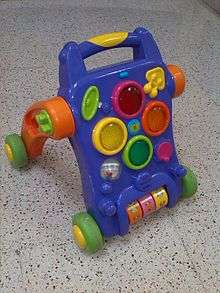Baby walker

A baby walker is a device that can be used by infants who cannot walk on their own to move from one place to another. Modern baby walkers have a base made of hard plastic sitting on top of wheels and a suspended fabric seat with two leg holes.
Cause of developmental delays
Many parents believe that such walkers teach a child to walk faster. However, they may actually delay walking by two to three weeks for a typical child.[1] The amount of use matters; for every 24 hours babies spend in a baby walker (for example, one hour per day for 24 days), they learn to walk three days later and to stand four days later than they would have.[2]
Safety issues
Baby walkers have also led to many preventable injuries. These include injuries from falling down stairs while moving around in the baby walker, often with injuries that are worse than typical for falling down the stairs.[3]
The U.S. Consumer Product Safety Commission, American Academy of Pediatrics, Kids In Danger, and other organizations have issued warnings to discourage parents from using baby walkers.
Direct education of parents in a medical setting reduces parents' willingness to use these devices.[3][4]
In Canada, the sale of baby walkers was banned on April 7, 2004.[5][6][7] Canada is the first country in the world to ban the sale, importation and advertisement of baby walkers. This ban extends to modified and second hand baby walkers, including those sold at a yard sales or flea markets.[5] The Consumers Product Safety Improvement Act of 2008 (CPSIA) changed the items that were allowed to be sold at such sales.[8] Owners of baby walkers may be fined up to CA $100,000 or sentenced to up to six months in jail.[9]
There is some promising evidence that greater government regulation of baby walker designs can reduce the number of injuries due to falling while using a baby walker.[3]
Alternatives

Parent-assisted baby walkers were developed as an alternative to traditional baby walkers. These types of baby walkers differ greatly from traditional baby walkers as they have no wheels and require full parent assistance while in use. The design of modern parent-assisted baby walkers is similar to leading strings in that the child is suspended upright from straps while learning to walk. Parent-assisted baby walkers offer a safer method for teaching a child to walk over traditional baby walkers that can be unattended while in use.[10]
There are also immobile play centers, which look very similar to baby walkers, but which have no wheels. Consequently, the baby is unable to move to dangerous locations.
Some toys with wheels are designed for young children to hold on to while they are walking.
History

Baby walkers were known as early as the 15th century in Europe. An illumination in the Hours of Catherine of Cleves, a Dutch manuscript from that time, depicts the infant Jesus in a wooden baby walker.[11]
Go-cart was a common historical name for the wheeled version.[12] Other alternatives were also used. A baby-runner was a padded wooden ring, set at the height of the baby's waist, on a pole that was fixed into the floor and ceiling. The baby was placed inside the ring and able to move in a circle around the pole. This prevented the baby from reaching dangerous places, such as hot ovens.[12]
References
- ↑ Burrows P, Griffiths P (November 2002). "Do baby walkers delay onset of walking in young children?". Br J Community Nurs. 7 (11): 581–6. doi:10.12968/bjcn.2002.7.11.10889. PMID 12447120.
- ↑ Garrett, M; McElroy, A M; Staines, A (2002-06-22). "Locomotor milestones and babywalkers: cross sectional study". BMJ : British Medical Journal. 324 (7352): 1494. doi:10.1136/bmj.324.7352.1494. ISSN 0959-8138. PMC 116446
 . PMID 12077035.
. PMID 12077035. - 1 2 3 Gielen, Andrea C.; McDonald, Eileen M.; Shields, Wendy (2015-01-01). "Unintentional Home Injuries Across the Life Span: Problems and Solutions". Annual Review of Public Health. 36 (1): 231–253. doi:10.1146/annurev-publhealth-031914-122722. PMID 25581150 – via Annual Reviews.
- ↑ Young, Ben; Wynn, Persephone M.; He, Zhimin; Kendrick, Denise (2013-11-01). "Preventing childhood falls within the home: overview of systematic reviews and a systematic review of primary studies". Accident Analysis and Prevention. 60: 158–171. doi:10.1016/j.aap.2013.08.001. ISSN 1879-2057. PMID 24080473.
- 1 2 "Baby Walker Information from Health Sciences Centre in Winnipeg, Canada". Archived from the original on 2008-10-21.
- ↑ "Injury Data Analysis Leads to Baby Walker Ban".
- ↑ "Baby walkers outlawed in Canada". Retrieved 2015-08-31.
- ↑ "CPSIA Changes". CPSC. 2008.
- ↑ Greene, Alan (22 February 2010). "The Dangers of Baby Walkers". New York Times. /
- ↑ "The Juppy Baby Walker". Yahoo! News. 2010.
- ↑ Lamar, Cyriaque (23 October 2012). "Behold, the divine baby walker of Jesus Christ". io9. Retrieved 24 October 2012.
- 1 2 Snodgrass, Mary Ellen (2004-12-29). Encyclopedia of Kitchen History. Routledge. p. 201. ISBN 9781135455729.
External links
| Wikimedia Commons has media related to Baby walkers. |